Remembering Long Island's legendary clubs: Malibu, OBI, Boardy Barn and more
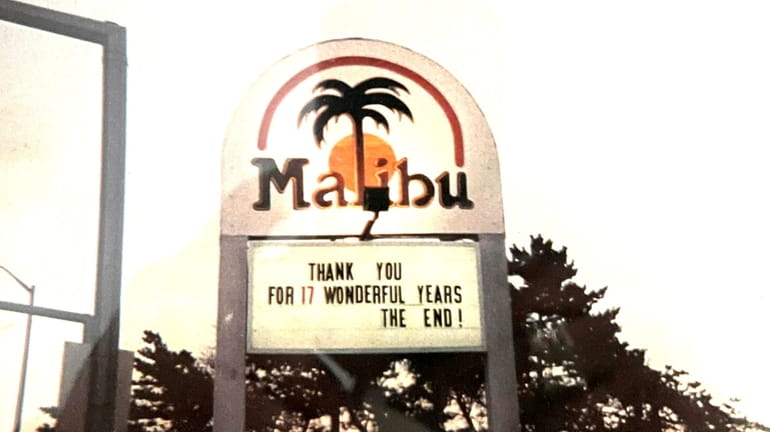
Malibu's sign during the club's final days in 1996. Credit: Malibu
From the late 1970s to the early '90s, dance clubs were thriving around Long Island. Going out and being social took precedence over today's at-home streaming and online video gaming. No one was swiping apps; all interaction was face-to-face.
Here's a look back at six clubs — ranging from summertime staples to rock palaces and discos — that once defined Nassau and Suffolk nightlife. And while they are all gone, the memories remain strong.
MALIBU
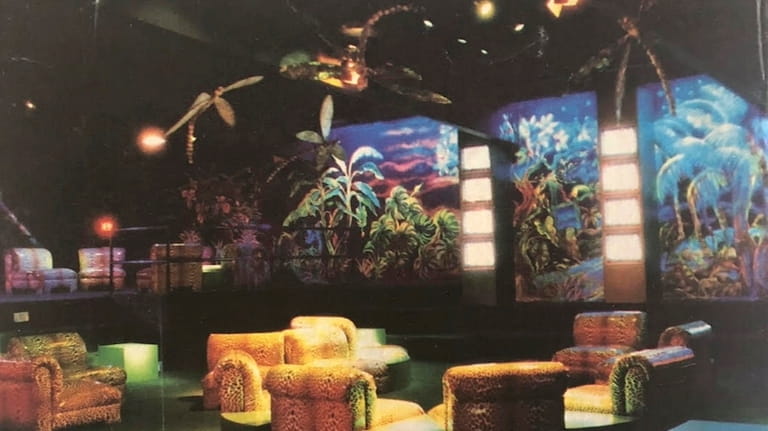
Interior of Malibu in Lido Beach. Credit: Malibu
Perhaps Long Island’s most beloved club is Malibu in Lido Beach, where the Greco brothers, Tony and Charlie, set out to build a new-style venue.
“We were looking for the next big thing,” says co-owner Tony Greco. “Instead of building a discothèque, we wanted to put up-and-coming live bands in the venue. Most places to see live bands on Long Island consisted of a sit-down experience. We wanted to do danceable rock and roll music.”
The building, formerly known as The Malibu Beach and Shore Club in the late ‘50s, held 2,000 people and featured two rooms. The first room, to the right, featured dance music while the main room, to the left, focused on New Wave and alternative sounds. The décor was centered around a tropical theme with palm trees, gold statues as well as dragonflies hanging from the ceiling.
“Malibu was the Taj Mahal of Long Island clubs,” says regular Tom Polito, 53, of Babylon Village. “It was the biggest and the best.”
Former Long Beach resident Rhonda Weiss, who is in her 60s, adds, “The music they played was the soundtrack of my life in my 20s. It was a world-class dance club 15 minutes from my house. There was nothing like it.”
Many legendary live shows took place on the Malibu stage including Cyndi Lauper, the Go-Go’s, David Lee Roth, Extreme, Eddie Money, Billy Idol, George Thorogood, the B-52’s, Squeeze, Meat Loaf, Culture Club, John Cougar, the Ramones, Squeeze, The Knack, the Stray Cats, They Might Be Giants, Adam Ant, Smashing Pumpkins, Deborah Harry, Dream Theater, Faith No More, Anthrax, Hall & Oates and more.
On Dec. 13, 1981, U2 closed out its North American “October Tour” at Malibu playing soon-to-be-classics like “I Will Follow” and “Out of Control.”
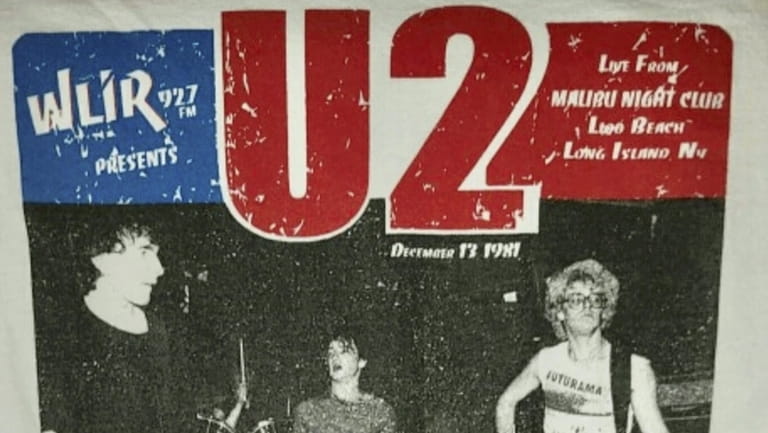
A vintage T-shirt from the concert U2 headlined at Malibu in Lido Beach on Dec. 13, 1981. Credit: Derek Fowler
“They were really good. It was a mind blower that they became so huge. At the time, I had no idea who they were,” says Tina Traina-O’Brien, 62, who grew up in Franklin Square and caught the show. “I thought the lead singer was charismatic and instantly became a big fan.”
When Long Beach resident Joan Jett played Malibu on the week her single “I Love Rock 'N Roll” hit the top of the Billboard chart in 1982, she drew a massive crowd.
“There was such bedlam that state police closed down the Meadowbrook Parkway south of Sunrise Highway because of traffic,” recalls Greco. “The Nassau County Fire Commissioner came in to check our attendance. We were within legal occupancy, but Joan ended up having to cut her set short.”
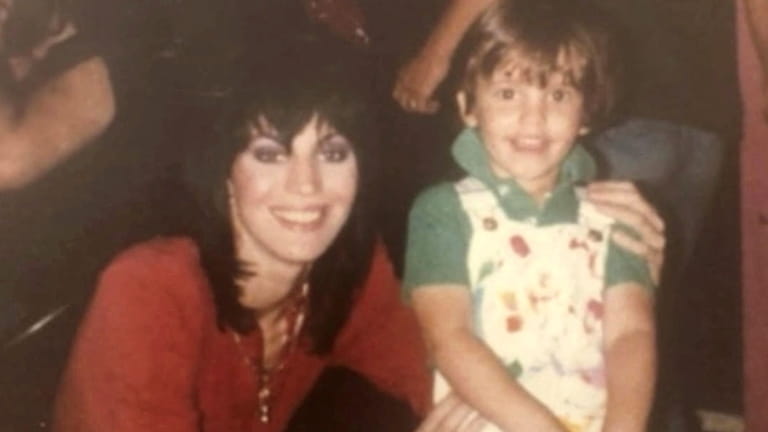
Joan Jett with co-owner Tony Greco's son Anthony at Malibu in Lido Beach. Credit: Malibu
Even the late Tony Bennett dropped in on Nov. 26, 1989, when he did a quick set before Flesh for Lulu took the stage.
“The moment was amazing and everybody loved it,” says Polito, who was in the front row. “The cool part was in the New Wave scene there was no judgment.”
WLIR/WDRE (92.7 FM) had a vibrant connection with Malibu. In fact, every week from 1983 to 1991 the station broadcast live from the club for its “Saturday Night Dance Party” from 9 p.m. to 2 a.m. with WLIR/WDRE DJ Larry “The Duck” Dunn.
“We fed off each other,” says Dunn. “They needed us to promote and they provided the dance floor plus live bands.”
Even Billy Joel filmed his “Piano Man” video at the club.
“It was shot in the room we called Charlie’s Piano Bar. They changed it to make it look like a barroom with the piano up on a stage and all the people around it,” said Greco. “After the production was done, Billy did a mini-concert for everyone there. He played for about an hour singing all his tunes.”
OAK BEACH INN
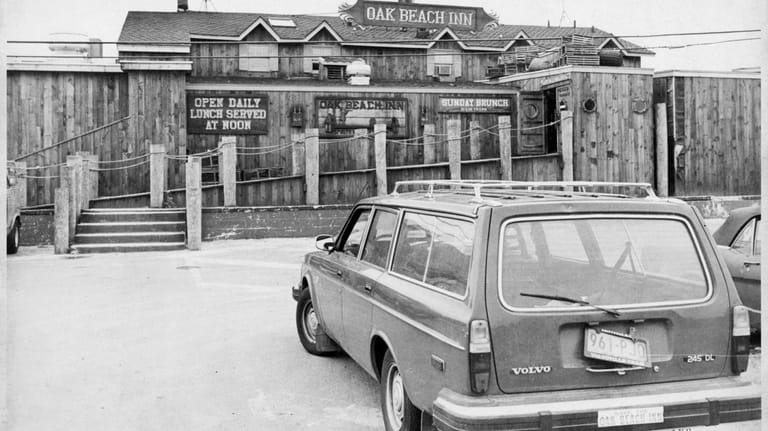
The Oak Beach Inn in Oak Beach in 1980. The car in front of the restaurant has a "Save the Oak Beach Inn" bumper sticker. Credit: Newsday/Daniel Goodrich
Those looking for a beach vibe took the journey down Ocean Parkway to the Oak Beach Inn or OBI as it's usually called — overlooking the Great South Bay in Oak Beach. Customers wore T-shirts, shorts, flip-flops and crop-tops. Some people would arrive by boat and dock their vessel in a slip.
“OBI was cool because there were so many areas you could go,” says Jacelyn Sanchez, 52, of Glen Cove, who went regularly during the summer in the '90s. “The dance floor was inside, upstairs they had karaoke or you could hang out on the deck outside.”
The music was a generic blend of Top 40 and classic rock with the signature house drink being the famous Long Island Iced Tea, which many claim originated at this venue. There was also a bungee drop challenge outside.
“People would have five beers and do a bungee drop and barely clear the sand underneath,” says Dunn, who used to spin at OBI. “It was crazy.”
OBI was so popular it expanded to three other locations: OBI North in Smithtown, OBI East in Hampton Bays and OBI West in Island Park. However, owner Robert W. Matherson faced some difficulties with local officials at the original club regarding noise levels and parking issues. Matherson reacted by launching a “Move Out of New York Before It’s Too Late” campaign and had club patrons put “Save the Oak Beach Inn” bumper stickers on their cars. Eventually, Matherson sold the business, in 1999, left Long Island and wrote a book about the controversy called, “Scandal at the Oak Beach Inn: Political Corruption vs. Long Island’s Hottest Nightclub.”
BOARDY BARN
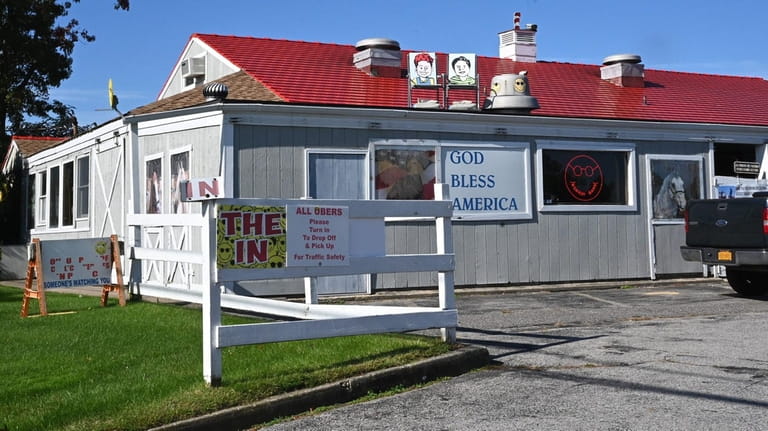
The Boardy Barn, at 270 W. Montauk Hwy. in Hampton Bays, is seen in October 2021. Credit: James Carbone
Those who headed out east to Hampton Bays in the summer can’t forget Sunday afternoons at the Boardy Barn, located on Montauk Highway. This outdoor romp took place under a red-and-white striped tent with suds-a-flowin’.
“The Boardy Barn was very down and dirty — filled with college kids dancing and singing,” says Michele Diamond, who summered in the Hamptons with her friends from 1988-1993. “It was everybody’s last hurrah for the weekend.”
The place was known for blaring singalong anthems like “I Will Survive,” by Gloria Gaynor, Neil Diamond’s “Sweet Caroline,” “Y.M.C.A.” from the Village People, Don McLean’s “American Pie” and “You Shook Me All Night Long,” by AC/DC. People would sing in unison and cover each other in yellow smiley stickers, which served as the venue’s logo.
“It was a nonstop party from the moment they opened to the moment they closed,” says former WBAB DJ Keith Fingers, who hosted events there. “People were hootin’ it up under the tent. You went there to get drunk, smile, laugh and throw up.”
Gina Bennicasa, 55, of Merrick shared a house with a group of friends from 1986 to 1996 and during that time the Boardy Barn was a regular stop on her schedule.
“The whole experience was very social but crazy,” she says. “We all had special Boardy Barn shoes, which were washable because by the end of the day they were always dirty and beer soaked.”
Bennicasa and her gang even had a unique way to consume their brew.
“We’d lay down on the floor on our stomachs, lineup cups of beer, take them with our teeth and just drink while people chanted,” she says. “It was sloppy … very sloppy!”
The Boardy Barn closed in 2020 and the property was sold to new owners who opened The Barnyard on the site earlier this year.
UNCLE SAM'S
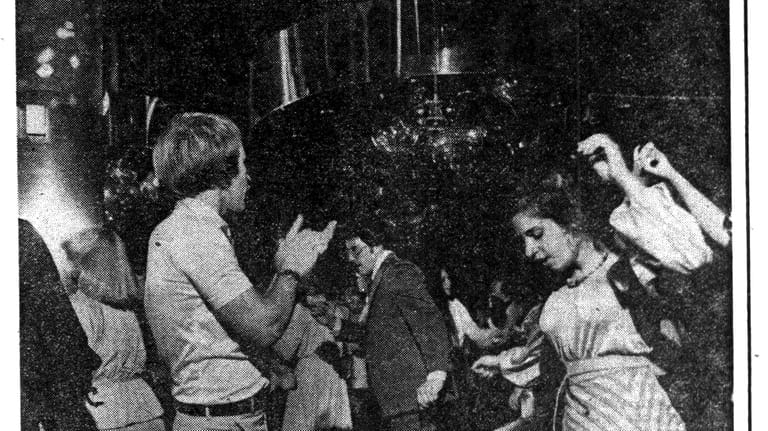
The dance floor at Uncle Sam's in Levittown. in 1978. Credit: Newsday/Gerald S. Williams
At the height of the “Saturday Night Fever” disco wave, Uncle Sam’s opened on Hempstead Turnpike in Levittown and Long Islanders were ready to boogie.
“The whole world started turning into discothèques,” says Tony Greco, who was a co-owner. “People were putting in lighting systems and hiring disc jockeys.”
The club was decked out with red carpets, disco balls, mirrors, polished railings and colorful lighting. Bouncers were dressed in tuxedos and bow ties while the cocktail waitresses wore tuxedo tails, black stockings, corsets and high heels. Plus, there was a strict dress code to get in.
“People used to get dressed up. No jeans were allowed. Men were required to wear a collared shirt and shoes,” says promotions manager Keith Hart. “Women arrived in nice dresses with big hair and a lot of makeup.”
Madonna came to Uncle Sam’s to perform a set of four songs ("Physical Attraction," "Holiday," "Everybody," "Burning Up”) while promoting her self-titled debut album on Sept. 24, 1983.
“She drew a big crowd. You couldn’t fit another person in the place,” says Hart. “Two weeks later she was playing rooms three-to-four times the size. We really hit it at just the right time.”
Traina-O’Brien used to go to Uncle Sam’s every Saturday night in her silky dress and high heels.
“Uncle Sam’s was really a classy place that was beautifully designed,” she says. “Once you hit the dance floor, you were there all night.”
SPIT
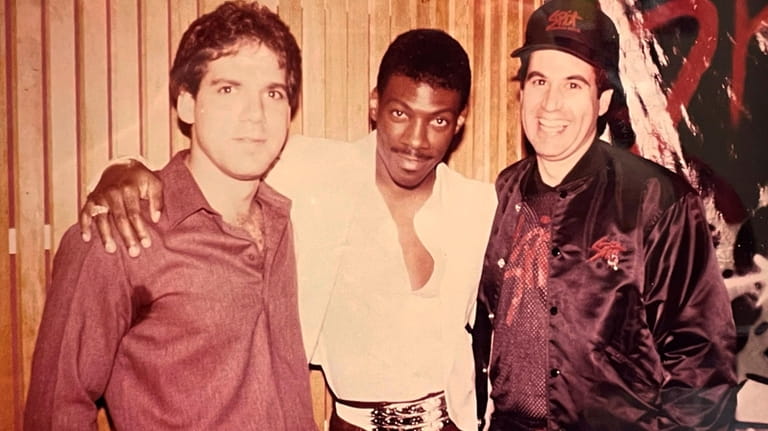
From left: promotions manager Keith Hart, comedian/actor Eddie Murphy and club co-owner Nick Paccione at Spit in Levittown. Credit: Keith Hart
Spit was a concept developed by the owners of Uncle Sam’s. On Wednesday nights, Uncle Sam’s would be converted into an alternative punk club.
“You entered through the back door. People thought they were coming to a different place,” says Hart. “The atmosphere was anti-disco. We put a chain-link fence around the dance floor and covered up anything sparkly. The place was even named with a disgusting title.”
The venue hit a new level of cool when local celebrities like Massapequa-native Brian Setzer of the Stray Cats and comedian-actor Eddie Murphy, who grew up in Roosevelt, started popping in.
“Eddie Murphy used to come a couple of times a month and hang out at the upper bar in the VIP lounge away from the dance floor with his entourage,” says Hahnzie Doodle of Massapequa Park, who worked as a cocktail waitress and bartender.
A landmark event occurred on Sept. 16, 1981, when Duran Duran played its first North American show at the club.
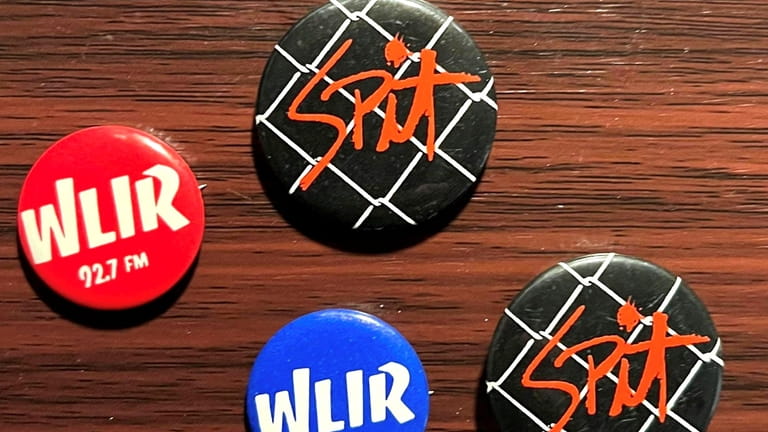
Promotional pins from WLIR and Spit given out to nightclub guests. Credit: Mark Contratti
“Duran was hot in the New Wave scene, but they hadn’t broken into the mainstream yet. They were on the verge,” says Doodle. “I could barely get through the crowd to serve drinks that night. The place was packed with stylish people and the sound was so incredibly loud.”
Spit had three levels with a 5,000-square foot dance floor allowing plenty of room to bust a move.
“It was a dark, cool place that blended New Wave and punk with an eclectic vibe,” says Deirdre Zoeters-Murphy, 55, formerly of Sayville, who met her husband at the club in 1989. “Most of the time I was dancing on top of a speaker near the bar. If I could have lived there, I would have.”
As Spit rose in popularity it was expanded to Monday nights when official auditions were held for the syndicated TV show, “Puttin’ on the Hits,” where contestants would lip sync to hit songs. (The show aired locally on WPIX/11.)
“We’d pick a winner every week,” says Hart. “The winner’s tape was sent to the producers of ‘Puttin' on the Hits.’ ”
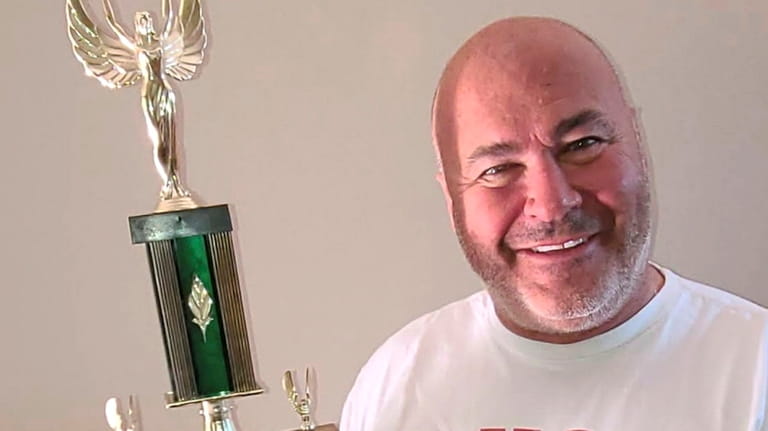
Derek Fowler, 59, who grew up in Lynbrook, with his second-place trophy he won at Spit in Levittown lip syncing to Modern English’s “I’d Stop the World and Melt With You.” Credit: Derek Fowler
Derek Fowler, 59, who grew up in Lynbrook, came in second place with Modern English’s “I Melt With You.”
“I still have my trophy,” says Fowler, who also got chosen to dance on Club MTV after being spotted at Spit. “I think the '80s to us were what the '50s were to our parents. We were able to dress as individuals and the music encouraged everyone to dance.”
SPIZE/SPIZE II
As the New Wave movement progressed, Spize opened on Route 110 in Farmingdale. Here New Wave, alternative, industrial and techno all came together. Attendees danced with spiky hair, mohawks and shaved heads, wearing ripped jeans tucked into combat boots, sleeveless collared shirts, garters, ripped fishnets, spandex, loafers and biker jackets.
“The crowd was mellow, but their look was grungy,” says DJ Charlie Kahrs, who spun on Friday nights.
Live bands like Modern English, Ministry, OMD (Orchestral Manoeuvres in the Dark), APB, Lords of the New Church and Gang of Four performed. R.E.M. appeared on April 26, 1983, during the band’s “Murmur Tour.”
By 1987, the place got a facelift, changing its name to Spize II with a black-and-white checkered dance floor covered in smoke from dry-ice machines and black walls decorated with graffiti.
“Spize allowed you to be who you wanted to be,” says DJ Chris Gray, who worked the turntable on Saturday nights. “It was a place where you could be yourself. Punks, freaks, goths, nerds, gays, etc … we all got along.”
Due to the popularity of MTV, Spize became known as a video dance club where the DJs would play a song and project its accompanying video on giant screens. Songs like “Join in the Chant” by Nitzer Ebb and “Lucretia My Reflection” by Sisters of Mercy would pack the dance floor.
“One night we blew a fuse and the music went quiet, but the crowd kept the Dead Kennedys song I was playing going by singing it a cappella,” says Kahrs. “It was incredible!”
STILL SPINNIN’ AFTER ALL THESE YEARS
Although the clubs of yesteryear are gone, mobile DJ Tim Cody of Manorville is keeping the New Wave vibe going at various locations under the banner Subculture.
“The New Wave crowd is a bit older, but they are still looking for a good time,” says Cody of Alternative Sounds. “Going out dancing on a Friday night makes their week.”
During his set, Cody will typically hit on classics like “Bizarre Love Triangle” by New Order, “Personal Jesus” by Depeche Mode and “Din Daa Daa” by George Kranz. His goal is to get everybody moving.
“The crowd is picky about what new stuff I play,” he says. “They are stuck in their ways and constantly reminiscing about the good old days. If they don't know a song, they won't dance.”
From 1998 to 2003 Cody spun at Luxe, the club Tony and Charlie Greco opened after Malibu closed. Here he learned how to work the floor.
“They knew how to run a club,” says Cody. “Charlie would watch the dance floor like a hawk. There could be 900 people there and if a group left and exited the building, he'd tell me in a meeting the following week. He did that to keep me on my toes.”
These days, Cody provides New Wave sounds all around Long Island. In Nassau, he can be found at Rabbit’s Foot in Hicksville every second and fourth Friday of the month or every fifth Friday at Ridgewood Station in Wantagh. Over in Suffolk, catch Cody every third Friday at Gotham in Hauppauge or Thursday nights in the fall at Eleanor’s Lounge in Bohemia.
“Every week I change up my mix,” he says. “I spin according to the mood on the dance floor.”
— DAVID J. CRIBLEZ

